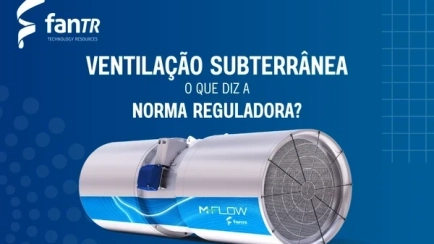
Underground Ventilation: What does the Regulatory Standard say?



Underground ventilation plays a fundamental role in mining activities across the world, but many people are unaware of its importance.
In Brazil, although there are several underground exploration mines, it is common to find people who are not familiar with their operations or even who have never had contact with the technology applied.
Underground Mining
It is crucial to understand that underground mines are not operated with carts and rails, as long ago depicted in cartoons. They have become highly mechanized, with galleries capable of supporting the traffic of large trucks to transport the extracted ore.
The deepest mines in Brazil reach depths of more than 1500 meters, and one of the main factors that make this exploration viable is forced ventilation.


It is important to emphasize that underground mines, although they present risks, have advanced safety systems, extraction points, and refuge chambers. Furthermore, they have significant advantages, especially when we evaluate environmental aspects, as they cause less damage to the surface and reduce deforestation compared to open pit mining.
Therefore, it is essential to expand knowledge and raise people's awareness about the importance of the activity as well as ventilation for the underground mining sector as it is a valuable extractive resource. Understanding the technologies and processes used in this type of mining allows us to recognize the advances achieved, as well as their positive impacts in environmental and operational safety terms.
Underground Ventilation: What does the Regulatory Standard say?
When developing underground mining, it is essential to consider the need for forced ventilation and, to determine the required airflow, it is necessary to take into account several factors as provided for in the regulatory standard NR 22.
According to the standard, from ten meters into development galleries, it is necessary to install equipment for forced ventilation. It is necessary to ensure air renewal, preventing stale, contaminated air from mixing with injected clean air, and ensuring minimum airflow so that it does not stagnate.
Therefore, the main purpose of the NR22 standard is to establish parameters and guidelines to ensure the creation of a healthy and safe working environment in underground mining operations. These parameters cover air renewal and the adequate supply of oxygen to the environment, as well as gas dilution and thermal exchange inside the mine. These measures are necessary to deal with challenges such as the heat generated by operating equipment and the geothermal gradient of the rock to be explored.
The Standard also includes specific treatments depending on the type of operation and the ore to be extracted, consequently, the minimum volume of air to be injected also varies according to these factors. In the case of coal mines, due to their unsanitary conditions and the presence of explosive gases, air volume requests are greater.
We must always work in balance, the standard not only deals with minimum and maximum volumes but also with maximum airflow speeds within inhabited galleries, where workers are present. In an exploration gallery, airspeed cannot exceed 8 m/s, which would be a wind speed of close to 30 kph. If a greater quantity of air is required than supported by the gallery, there are alternatives such as increasing the area of the gallery, drilling a parallel gallery, or raising (a chimney) for induction or exhaust, and thus equalizing the system to supply the desired/needed volume.
The calculation of sizing these needs involves some factors; it must necessarily take into account the number of people, the amount of equipment in operation, the amount of explosives used, and the number of tons extracted per month.It is essential to adhere to ventilation standards and procedures, in addition to properly preparing equipment, in order to ensure a safe environment in underground mining and facilitate its operation.
Share your questions and ideas with us by contacting us below.